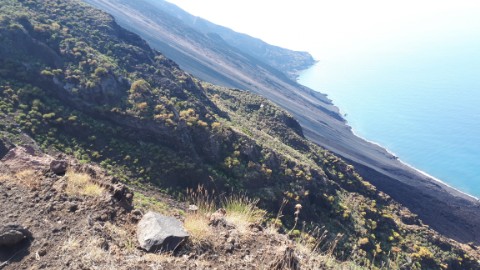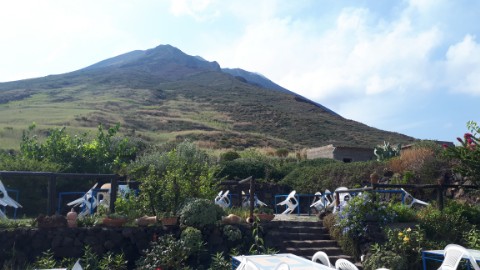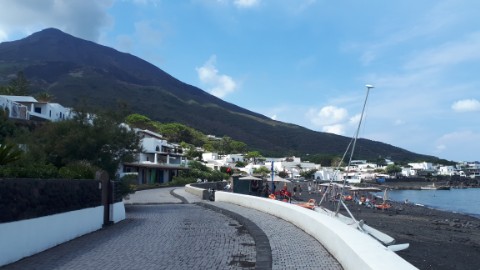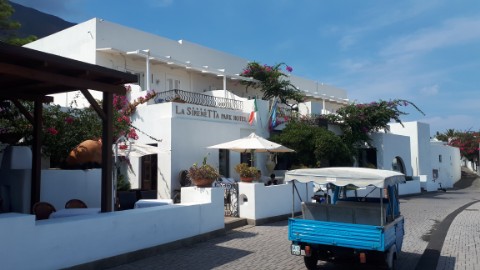Article published on Maxx Silver music from contributor, with permission - copyright 2020
Just one week after the second huge volcanic eruption in less than two months, our correspondent visits the Italian island of Stromboli and finds a community determined that it is business as usual.
Stromboli, less than three miles wide and over 50 miles by boat from the Northern shore of Sicily is a volcanic island visited by tourists, often by boat tours from larger resorts such as Lipari.
It was considered unique as you could, in reasonable safety, climb 3000 feet to overlook the crater rim to watch, close at hand, frequent eruptions of molten orange projectiles being thrown several hundred feet in the air from the crater. A supposedly safe, but rather spectacular, natural firework display.
However the volcano on Stromboli made headlines on 3rd July 2019 when a huge explosion (officially a “Paroxysm”) killed a Brazilian tourist Massimo Imbesi on its slopes and sent a huge mushroom cloud of dust and ash several miles into the atmosphere. The worrying thing about that explosion was that it was not predicted, or indeed, predictable. Dozens of tourists were due to trek up to the crater two hours later on that very evening and would have been exposed to the pulverising and deadly force of 1000 degree lava bombs, ash and molten rocks. If the Volcano had waited a while longer before erupting it would not just have been poor Massimo who was affected.
Analysis at the time suggested that, as with previous explosions in 2003 and 2014 that things would calm down. Local experts monitoring the situation said as much.
However Stromboli remained angry throughout the Summer and this culminated in another huge explosion on 28th August. Various videos on social media show a boat crew trying to escape a huge pyroclastic flow of rock and dust actually moving quickly above the ocean. Activity remained very high right up until the end of August with more overnight large explosions.
So it was, that I visited an island on Orange alert, welcomed by a severe thunderstorm and torrential rain, on 4TH September 2019 after an 11 hour trip from my home in South London. For a normally cautious tourist it all seemed rather too much like a Bear Grylls TV programme for comfort. A potential passport into hell and a stressful time looking skywards for new eruptions was promised. A Red Alert would mean instant evacuation from the island.
But the cheery manner at the Hotel didn’t match with this analysis. “How is the volcano?” I asked “Iddu? He is ok today. He is calming down” Locals call the mountain “Iddu” meaning “him” with some affection and maybe a little humour. He may be considered a portly old man, who smokes too much, has a bad gas problem ( Stromboli was releasing 600 cubic tonnes of sulphur gas a week during the Summer) and a tendency to belch molten rock on a regular basis, normally every 10 to 30 minutes.
The torrential rain and thunder outside my hotel room had made for a dramatic welcome. But the islanders needed the rain. Dry since May, both eruptions had caused brush fires on the slopes of the volcano as everything was tinder dry. Brave pilots of water planes from the mainland scooped up sea water and whilst flying low. doused the flames before they got close to the houses in the main town of Stromboli. But scars still appear on the side of the mountain from these fires. Also the eruption on the 28th had covered large areas with black, volcanic dust which continued to wash off roofs around the hotel meaning the cleaner was busy the whole of the next day with a mop and bucket, persistently cleaning the black sand away from every corner.
The main town of Stromboli is the safest place to be in the island. Nobody has been injured by the volcano here since around 1930. Traffic consists of a few 3 wheeled carts or golf buggies that only take tourists to and from the ports during the infrequent ferry visits. There is scarcely a conventional car anywhere, so narrow are the white walled streets, painted to help nullify the lack of street lights on the island.
The main danger is a remote possibility of a large Tsunami if the mountain has a collapsed flank into the sea displacing the ocean. But many other destinations, especially in the Far East have a much greater risk (and record) of such happenings. But even so, it is as well to memorise the yellow signposts which point to paths that lead quickly to higher ground around the church. The usual statistic about crossing a busy road applies, visiting Stromboli Town is not dangerous. It is far safer than venturing forth onto a pelican crossing. Air quality can be influenced by the presence of gasses from the Volcano, but Piccadilly Circus has considerably more sulphur content in the air than a discharging volcano does.
Ginostra though, a small hamlet on the other side of the island has suffered the most and 20 million Euros of damage, caused on 3rd July has increased further from the more recent explosion. As I passed by on a boat Ginostra seemed like the land time had forgot, rocky, burned and barren. The few houses clinging to the cliffs holding on as if in adversity. A charming local Lipari resident told me to avoid this area “to be safe” whilst the orange alert was in force. I was not going to ignore her advice, she seemed genuinely concerned.


There are only some 500 residents on Stromboli and they rely on Tourism for their livelihoods. So this turbulent season of 2019 has meant cancelled bookings and already fewer reservations for 2020. In this respect, the door is left ajar to warmly welcome more visitors but more explosions from “him” could slam it shut, adversely affecting the prospects of everyone who lives on the island.
Up at the Osservatorio this is felt more keenly than elsewhere. The closest building to the Volcano on the Stromboli town side, this is a restaurant where you can watch ( as I did) volcanic eruptions into the evening with a pizza and sweet Malvasia, a local wine from Salina island. There is no reason to go to this remote spot other than to watch the volcano. But that is an extremely good reason.
The staff were busy with brushes cleaning all the pristine white plastic chairs, determined that no sign of black sand or dust should appear. One can only imagine the terror of the eruption the week before my visit at this proximity but there are meals to cook and drinks to serve. I can only admire the determination you would need to even open a restaurant, so soon after the whole area was affected, pretty seriously. Staff had located to the nearby concrete bunker for an uncomfortable couple of hours.
The walk up the mountain itself revealed several inches of black ash in most places on the path though the heavy thunderstorm had washed the foliage of huge towering grasses a reassuring green. . I ventured up to the closest spot I was allowed to view eruptions at the Sciara del Fuoco ( "Street of Fire" ) a third of the way up the mountain. I found a wild, beautiful and yes peaceful scene. The rumbles from the volcano were gentle and would scarcely drown out the mild indigestion I had within myself through my initial nerves at being there.
A black scar of fine, rocky, material stretching almost a mile from the mountain top to the ocean created a few extra feet of coastline the week before my visit. Effectively a new part of the world which threw utterly beautiful shadowy shapes set against the deep blue of the ocean beneath.
The sheer charm and character of this wonderful place becomes abundantly clear at this point. It is so remote and wild that it could have been exactly this way thousands of years ago. The visit left me thinking I had learned something about our relationship with the planet we live on. I had some vague idea that perhaps Stromboli was an example of how things should be.
The local coastguard was keeping boats outside of a 2 km exclusion zone from the coast and I heard reports of local police preventing tourists going further up the mountain. Rumours abound however with the guests of walking tours still continuing to higher than the permitted area though I did not see this myself.
As evening turned to night I walked back into the town from the restaurant on a path without streetlights. The stars are unbelievably bright in a place with no light pollution. Tourists have the appearance of coal miners coming down from the mountain with their helmets and bright lights attached to their heads. I only had my mobile phone to light my way. However In the town itself that rarity, a Lightship, had visited and doused the harbour with a stark, white glare so people can walk along the black sand beaches and coastal streets. I think I preferred it in the dark.
I returned to the my hotel and to the news the locals had been waiting for. The volcano was down to a yellow alert, immediate danger had passed. But nobody would be allowed up the mountain for the 2019 season, and most likely quite a way into 2020. All the signs from the numerous monitoring stations, decreased tremors, amplitude and emissions pointed to Stromboli becoming the friendly mountain locals were more used to. But as someone told me “we need him to be quiet for a hundred years now”
And for the sake of the lives of the lovely, friendly people who live on this raw, beautiful and unique place, I certainly hope that happens.
Our correspondent stayed in La Sirenetta-Park Hotel Stromboli which is highly recommended
He flew Gatwick – Catania with EasyJet then obtained a 90 minute transfer to Milazzo Port. From there is a 3 hour boat journey to the island of Stromboli. There is no quicker way of getting there.
He used “The Siclian Experience” Italia Del Mondo who arranged transfers and recommended accommodation to him on a trip through 5 islands
Also featured Osservatorio restaurant (booking recommended) where you can watch an erupting volcano.
You can also watch Stromboli live eruptions from the following webcams
https://www.skylinewebcams.com/en/webcam/italia/sicilia/messina/stromboli.html
https://www.skylinewebcams.com/en/webcam/italia/sicilia/messina/stromboli-sciara-del-fuoco.html
Article written by Michael Seabrook copyright 2020 published with permission.


